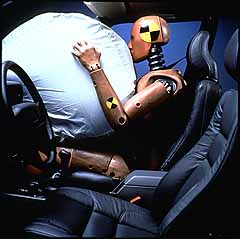
There's no denying it; air bags do save lives. According to the National Highway Traffic Safety Administration (NHTSA), about 1600 accident victims are alive today because of an air bag. However, air bags can also kill. The decapitation of a one-year-old girl in Idaho just before Thanksgiving of 1996 increased the number of child fatalities caused by air bags to 32 since the industry first began installing the passive safety devices in large numbers in the early 1990s. Hopefully, this tragedy will be the wake-up call that ends this madness.

There is something quite simple each of us can do to prevent air bag injury or death: DO NOT ALLOW CHILDREN IN THE FRONT SEAT even in a proper safety seat. The safest place for a child in a passenger vehicle is in the middle of the back seat, PROPERLY BELTED, or in a correctly installed safety seat. That's easy to say, but maybe not so easy to remember when dealing with a cranky child or your mind is elsewhere as you're late for an orthodontist appointment or touring the mall parking lot looking for a spot to park.
NHTSA and many consumers have long felt that automakers have an obligation to remind us about air bag danger by placing big warning labels where we can see them (not on a tiny tag on the underside of the visor where they are currently placed) in all vehicles equipped with passenger-side air bags.
The only active response from the automotive industry to this request so far has come from the Big Three automakers (GM, Ford and Chrysler.) They announced that they will send letters to the owners of 22 million cars with passenger-side air bags warning them that the devices can kill or maim children. No word, however, about the envelope containing a stick-on warning label for the car.
Since the recent Idaho tragedy, NHTSA now requires that all new cars for sale to consumers carry several attention-getting air bag warning labels; two are to replace the existing visor labels; at least one more goes on the dash.

Volvo, an industry leader in automobile safety, with features like the side-impact air bag, says that their vehicle's manual has carried a warning against placing children in the front seat since 1993. Unfortunately, not all new car buyers read the owner's manual.
"People spend a weekend programming their $200 VCR using instructions from a manual," says Volvo spokesperson Dan Johnston, "but they buy a $30,000 car and never open the owner's manual." Johnston also emphasizes that only persons 4'7" or taller should ride in the front passenger seat [ever]. "Because of the way the air bag deploys," he says, "height should be the determining factor, not age or weight."
Johnston says Volvo likes the idea of a passenger-side air bag cutoff switch similar to the system currently in some pickups. However, he prefers a device that is tied to the ignition, preventing the driver from starting the car before indicating whether the bag is "on or off."
The automaker also favors decreasing the power of the air bag so it deploys with less force. Volvo says the "smart" air bag is a good solution, however, they are concerned whether or not current "smart" bag technology can do the job.
NHTSA expressed their anxiety over the number of deaths due to passenger-side air bag deployment by announcing in late November, 1996 a five-point plan to help prevent these tragedies. The plan includes:
Put brightly-colored labels on new cars and light trucks warning that air bags can kill children and stating that all children under 12 should be in the back seat. The stickers would not be required in vehicles equipped with a "smart" air bag system.
Require "smart" air bags on all cars by the fall of 1998. Through sensors and other devices now under development, "smart" bags will automatically deactivate the air bag when sensing a rear-facing child seat or an unbelted, out-of-position child or will deploy at different speeds or inflation levels depending on what is "sensed" in the passenger seat.
Reduce the rate of air bag inflation by 20 to 35 percent until "smart" bags come into use.
Extend until December 1, 2000, the time automakers may install cutoff switches in vehicles without rear seats or with rear seats too small for child-safety seats.
Allow mechanics to disconnect the air bags for car owners. Currently, this procedure is forbidden.
These Federal directives undoubtedly will help alleviate horrific accidents and lessen injuries by causing automakers to change the potentially deadly qualities of the air bag. However, as Volvo's Johnston says, "We can only bring so much to the party." The rest is up to you.




